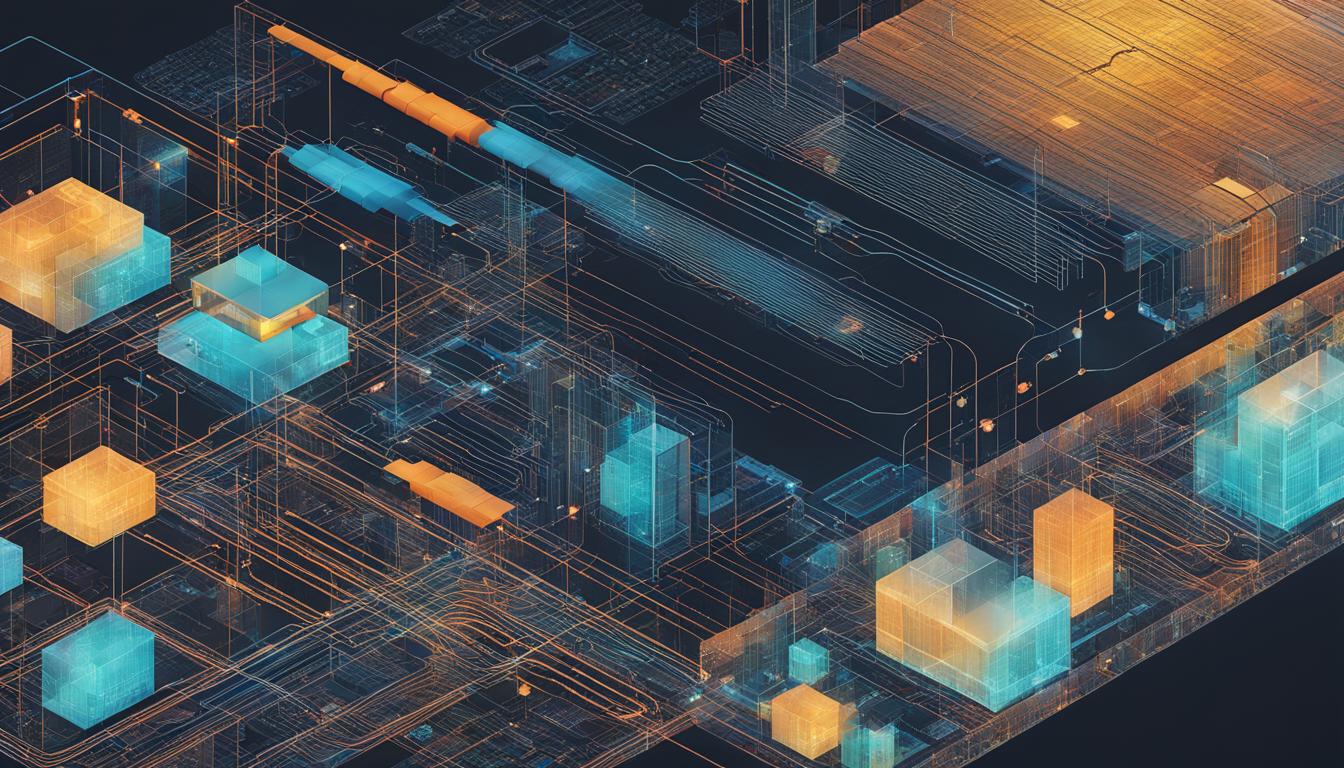IT infrastructure, also known as technology infrastructure, is the combined components necessary for the operation and management of enterprise IT services and environments. It serves as the backbone of modern technology and plays a pivotal role in current IT landscapes.
A well-implemented and flexible IT infrastructure can help businesses improve communication, increase productivity, make quick decisions based on real-time data, and provide a positive customer experience. It consists of hardware components such as desktop computers, servers, data centers, hubs, routers, switches, and facilities, as well as software components like content management systems, customer relationship management, enterprise resource planning, operating systems, and web servers.
There are two primary types of IT infrastructure: traditional infrastructure, which is installed on-premises for company-only use, and cloud infrastructure, which allows users to access computing resources via the internet. An optimal IT infrastructure should provide high-performance storage, a low-latency network, security, an optimized wide area network (WAN), virtualization, and zero downtime.
Contents
Key Takeaways:
- IT infrastructure is essential for the operation and management of enterprise IT services.
- It consists of hardware and software components.
- The two primary types of IT infrastructure are traditional infrastructure and cloud infrastructure.
- An optimal IT infrastructure should provide high-performance storage, security, and virtualization.
- A well-implemented IT infrastructure can improve communication, increase productivity, and provide a positive customer experience.
Importance of IT Infrastructure in Business Success
A well-implemented IT infrastructure plays a critical role in the success of your business. It enables you to provide uninterrupted access to your websites and online stores, allowing your customers to browse and make purchases seamlessly. Furthermore, a robust IT infrastructure empowers you to develop and launch solutions to market quickly, giving you a competitive edge in the fast-paced digital landscape.
Real-time data has become a valuable asset for businesses in making quick and informed decisions. With an efficient IT infrastructure, you can collect and analyze real-time data, gaining valuable insights that enable you to respond swiftly to changing market trends.
“A flexible, reliable, and secure IT infrastructure can give businesses a competitive edge in the market.”
Employee productivity is also heavily dependent on a well-functioning IT infrastructure. By providing your team with the necessary tools and connectivity, you empower them to collaborate effectively and complete tasks efficiently. This not only improves productivity but also fosters a positive work environment.
On the other hand, a poorly implemented IT infrastructure can result in connectivity issues, decreased productivity, and security breaches. It can hinder your business operations, leading to dissatisfied customers and missed opportunities. Investing in a flexible, reliable, and secure infrastructure is crucial for your business’s profitability and long-term success.
Now that we understand the importance of IT infrastructure in business success, let’s dive deeper into the various components that make up an effective IT infrastructure.
Components of IT Infrastructure
| Hardware Components | Software Components |
|---|---|
|
|
| Facilities | Networks |
|
|
Having a clear understanding of these components will help you create and manage a robust IT infrastructure tailored to your business needs. In the next section, we will explore the different types of IT infrastructure available and their unique characteristics.
Components of IT Infrastructure
In order to understand IT infrastructure, it’s essential to delve into its various components. IT infrastructure is composed of hardware and software, each playing a key role in supporting the overall functionality of an organization’s technology environment.
Hardware Components
Hardware components form the physical foundation of IT infrastructure. They include:
- Desktop computers
- Servers
- Data centers
- Hubs
- Routers
- Switches
- Facilities
Facilities or physical plants provide a dedicated space for networking hardware, servers, and data centers. This includes essential elements like network cabling, ensuring seamless connectivity within office buildings.
Software Components
Software components are the digital building blocks that enable the operation and management of IT infrastructure. Key software components include:
- Content management systems
- Customer relationship management (CRM) software
- Enterprise resource planning (ERP) software
- Operating systems
- Web servers
Networks
Networks serve as the central nervous system of IT infrastructure, facilitating the communication and collaboration between devices. They are comprised of various components, including:
- Switches
- Routers
- Hubs
- Servers
These networking components connect devices within local area networks (LANs) and enable communication between devices across different LANs.
Servers
Servers are a core hardware component of IT infrastructure. They allow multiple users to access and share resources, such as data and applications. Servers are typically housed in dedicated server rooms or data centers, ensuring reliable and secure access to critical information.

Cloud infrastructure offers several advantages over traditional infrastructure. It provides scalability, allowing businesses to easily adjust their computing resources based on demand. It also eliminates the need for businesses to maintain and upgrade their own hardware, reducing costs and improving flexibility. Additionally, cloud infrastructure offers enhanced accessibility, enabling users to access their data and applications from anywhere, at any time.
Both traditional infrastructure and cloud infrastructure have their merits and are suitable for different business needs. The choice between the two depends on factors such as cost, scalability requirements, data security, and specific business objectives.
| Traditional Infrastructure | Cloud Infrastructure |
|---|---|
| Installed on-premises | Accessed via the internet |
| Requires significant resources | Offers scalability and flexibility |
| Higher upfront costs | Reduced hardware maintenance costs |
| Lower accessibility | Enhanced accessibility from anywhere |
IT Infrastructure Management
Managing and maintaining an efficient and reliable IT infrastructure is crucial for businesses to operate smoothly and stay competitive in today’s digital landscape. IT infrastructure management encompasses three key areas: IT operational management, IT service management, and IT asset management.
IT Operational Management
IT operational management focuses on maximizing the reliability and efficiency of the infrastructure. It involves tasks such as network asset discovery, operational analysis, and data collection to ensure optimal performance. By monitoring and analyzing the infrastructure, companies can proactively identify and resolve any issues that may arise, minimizing downtime and disruptions.
IT Service Management
IT service management is responsible for the design, creation, delivery, support, and lifecycle management of IT services within a business. Its primary goal is to optimize the deployment of IT solutions for users, ensuring that they have the necessary tools and resources to perform their tasks effectively. IT service management involves implementing industry best practices, streamlining processes, and providing excellent customer support to enhance user satisfaction.
IT Asset Management
IT asset management focuses on managing the life cycle of infrastructure components, including hardware and software assets. It encompasses tasks like procurement, inventory management, deployment, maintenance, and disposal of assets. Effective IT asset management helps organizations optimize support costs, maintain accurate inventory records, control the infrastructure, and manage software licenses efficiently.
By implementing robust IT infrastructure management practices, businesses can ensure the reliability, security, and performance of their technology systems. It enables them to minimize downtime, improve operational efficiency, and make informed decisions regarding infrastructure upgrades or investments.
| Benefits of IT Infrastructure Management |
|---|
| Enhanced reliability and uptime |
| Improved operational efficiency |
| Streamlined service delivery and support |
| Cost optimization through effective asset management |
| Minimized security risks |
| Optimized infrastructure performance |
Effective IT infrastructure management is essential for businesses to maximize the value of their technology investments and drive growth in an increasingly digital world.

Next, we’ll conclude our exploration of IT infrastructure by summarizing key takeaways and insights.
Conclusion
IT infrastructure in information technology is the backbone of enterprise IT services and environments, playing a crucial role in modern technology landscapes. By implementing a well-designed and flexible IT infrastructure, businesses can unlock a multitude of benefits. Improved communication, increased productivity, real-time data insights, and a positive customer experience are just a few advantages of a robust IT infrastructure.
Comprised of hardware and software components, IT infrastructure comes in two primary types. Traditional infrastructure refers to on-premises installations solely for company use, while cloud infrastructure allows users to access computing resources via the internet. Regardless of the type, proper IT infrastructure management is essential.
IT infrastructure management encompasses three core areas: IT operational management, IT service management, and IT asset management. These areas work together to maximize the reliability and efficiency of infrastructure, optimize the deployment of IT solutions, and manage the lifecycle of hardware and software assets.
In today’s digital landscape, a well-designed and optimized IT infrastructure is vital for the success of businesses. It provides the foundation for communication, productivity, and innovation, making it a key driver in staying competitive and meeting the evolving needs of customers.
FAQ
What is IT infrastructure?
IT infrastructure, also known as technology infrastructure, refers to the combined components necessary for the operation and management of enterprise IT services and environments. It serves as the backbone of modern technology and plays a pivotal role in current IT landscapes.
Why is IT infrastructure important in business?
A well-implemented and flexible IT infrastructure can help businesses improve communication, increase productivity, make quick decisions based on real-time data, and provide a positive customer experience. It is crucial for the success of a business as it allows companies to provide uninterrupted access to their websites and online stores, develop and launch solutions to market quickly, collect real-time data for quick decision-making, and improve employee productivity.
What are the components of IT infrastructure?
The components of IT infrastructure consist of hardware and software. Hardware components include desktop computers, servers, data centers, hubs, routers, switches, and facilities. Software components include content management systems, customer relationship management, enterprise resource planning, operating systems, and web servers.
What are the types of IT infrastructure?
The two primary types of IT infrastructure are traditional infrastructure and cloud infrastructure. Traditional infrastructure is installed on-premises for company-only use and includes facilities, data centers, servers, networking hardware, desktop computers, and enterprise application software solutions. Cloud infrastructure allows users to access computing resources via the internet and uses virtualization to connect physical servers maintained by a service provider.
What is IT infrastructure management?
IT infrastructure management involves three areas: IT operational management, IT service management, and IT asset management. IT operational management focuses on maximizing the reliability and efficiency of infrastructure, IT service management aims to optimize the deployment of IT solutions for users, and IT asset management involves managing the lifecycle of infrastructure.
What is the definition of IT infrastructure in information technology?
In information technology, IT infrastructure refers to the combined components necessary for the operation and management of enterprise IT services and environments. It plays a crucial role in modern tech and is essential for businesses to stay competitive.




